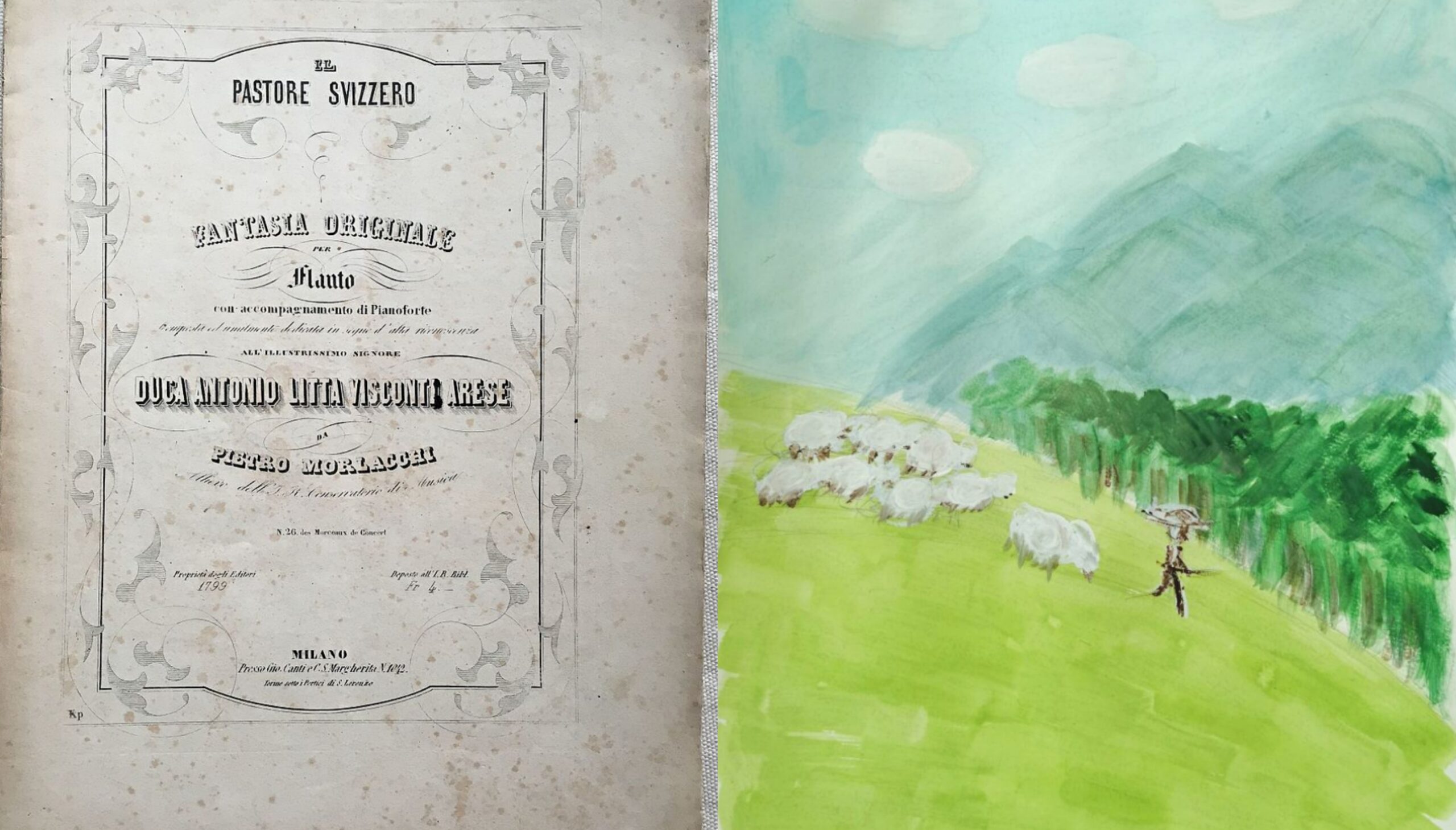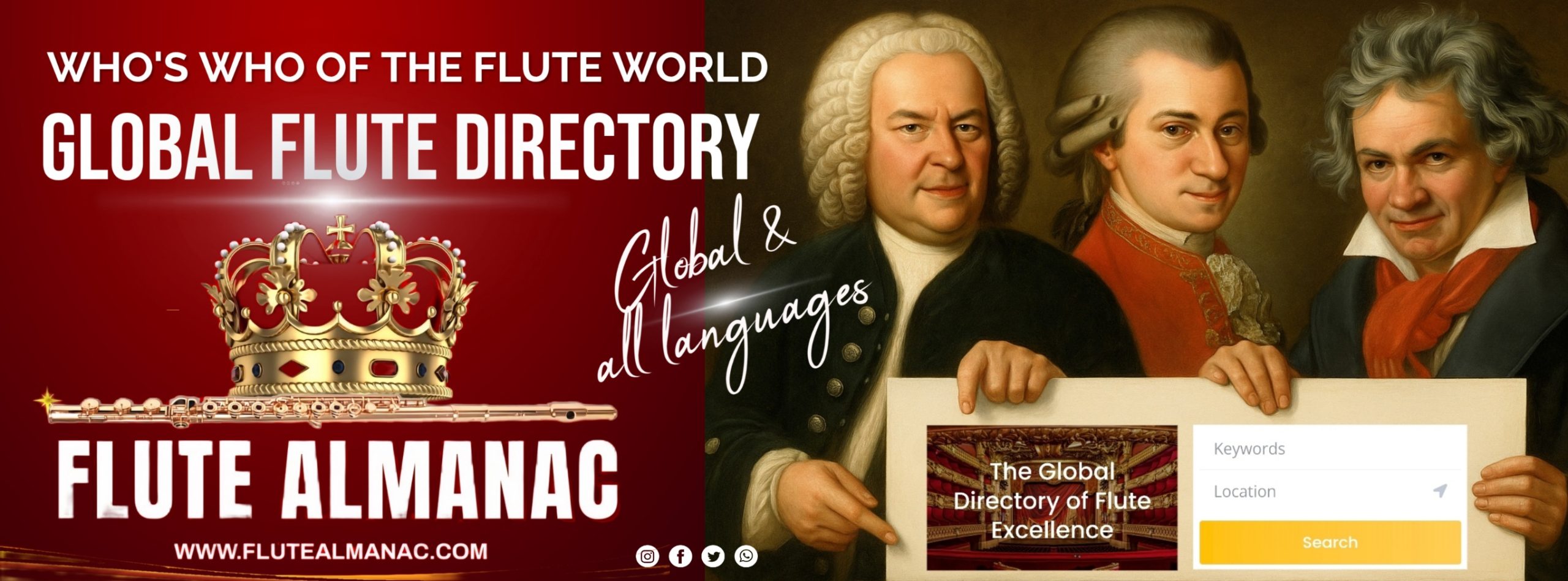
by Enrico Sartori
Almost every flute player is familiar with Il Pastore Svizzero (The Swiss Shepherd), a short piece for flute and piano written by Pietro Morlacchi.
It’s ofter performed in flute recitals and is generally liked by the audience as well, because it is very pleasant. After a lyric introduction, there is a theme and variations where the flute shows different virtuoso techniques, and ends with a final scherzo. Everything in about eight minutes of music.
While it seems very hard to play, and it is generally considered as a show off piece, it is not that complex to professional flute players especially when compared with other virtuoso repertoire of the same period, such as the solos by Demersseman (1833 – 1866) or the main repertoire for flute written in the XXth century.
Il Pastore Svizzero became a really well known pieces during the second half of the twentieth century, thanks to the famous Italian flute player, Severino Gazzelloni, who performed and recored the work several times. More recently, the flautist Sir James Galway performed the work all over the world, making numerous recordings and videos of it.
Today the piece is so popular that it is known in different versions and arrangements. It is often performed for solo flute and wind band, as well as solo flute and orchestra, where both the wind band and the orchestra are playing the original piano part. There are also other versions, such as the one for flute and flute orchestra, and even a version for solo piccolo and orchestra. In 2021, I was commissioned an arrangement for flute and string orchestra by the Kammer Orchester St. Gallen (Switzerland) which was performed in May of the same year.
While Il Pastore Svizzero, in its so many versions, it is so popular with flute players all over the world, there is almost no biographical information on the composer. It is in fact very hard to come up with some information to write on program notes when performing or recording the piece. Moreover, for a very long time Il Pastore Svizzero was often incorrectly attributed to Francesco Morlacchi (1784 – 1841), a very famous opera composer. Some speculations have been made about it, that it was a trick from the publishers to sell more copies, since people are more willing to buy something from a famous composer, such as Francesco Morlacchi, than an unknown flute player and composer as Pietro Morlacchi. Also, by looking at the original manuscript, there is no full first name in the signature, but only P. Morlacchi, and the letter P and the letter F are very similar in handwritten italic.

The mistakes still remain in more recent times, and while nowadays both Morlacchis are unknown to the general public and musician (especially if not Italian), some editions still use the name of Francesco Morlacchi, and the wrong name appears in many concert programs and recordings, including my very first CD published in 2001. As a curious note, there is one publisher that even attributes the composition to Francesco Pietro Morlacchi.
As of today, with plenty of information available on the internet as well as more published researches and articles on flute repertoire, Pietro Morlacchi is officially recognized as the composer of the piece. As a tangible proof of that, the work was composed and published in 1850, nine years after Francesco Morlacchi’s death.
Now let’s try to give some correct biographical information on Pietro Morlacchi. If you do a quick research online using is first and last name, you find out that there is no common agreement on his dates (both birth and death), as well as his place of birth. Many websites call Pietro Morlacchi a Swiss composer, probably because of the title of his most famous composition, the Swiss Shepherd.
Pietro Morlacchi (1828 – 1868)
Pietro Morlacchi was a flutist and composer born in Lainate, a small town just outside of Milan. Therefore he is considered an Italian composer, even though in those years, Milan and quite a big portion of Northern Italy was under the control of the Austro-Hungarian Empire.

He then enrolled at the conservatory of music in Milan, and studied flute from 1843 to 1850 with the famous flautist Giuseppe Rabboni, first flute at the Teatro alla Scala in Milan, one of the most prestigious opera theatres in the world.
Morlacchi soon distinguished himself as a very diligent student. His name appears on the periodical “Il Pirata”, a magazine on literature, arts and theatre published in Milan every Tuesday and Friday. In the edition of September 8th, 1846, under the section called “Stabilimenti” (Establishments), we find a list of all the student awards at the conservatory of Milan, and Pietro Morlacchi from Lainate received an award for flute.
During his last year as a student, Pietro Morlacchi wrote his most famous composition: Il Pastor Svizzero (The Swiss Shepherd) and the work was dedicated to the Duca (Duke) Antonio Litta Visconti Arese. The composition was published in 1850 by Francesco Lucca, a music publisher active at that time in Milan, whose company was later absorbed by the Ricordi company. In fact, we can also find Il Pastore Svizzero in the Ricordi historical archive catalogue.
The work can be divided into 3 main parts: an Andatino, the theme and variation, and the Scherzo. These are not like separate movements in a sonata, but they are all connected to each other, continuously.
The first part, Andantino, is preceded by a short introduction, 7 bars played on the piano the will lead to a solo virtuoso flute cadenza in g minor. We then go to the andantino section, in 3/8, which is the slow cantabile part, written in a style that recalls the one of Gaetano Donizetti. Over the flute part there is an indication: imitando la voce di Cornetta (imitating the sound of a cornet), which I believe it applies until the cadence on D7. After a small solo piano part, we find the same theme presented an octave higher, this time marked “dolce”. The second part, theme and variations is in the key of G major. I am almost certain that the theme, marked “canzonetta svizzera” (Swiss songs) in the piano part, is an original idea of Morlacchi. Because the melodic contour of the theme is disjunct, characterized by octave legato jumps and intervals of a sixth, the style is similar to the one of the Jodel, a popular Swiss folk song (or more correctly a typical folk song style of the entire Alps region). While the Jodel folk song is generally sung, it is characterized by rapid changes of pitch between the chest voice (or normal voice) and the high-pitch falsetto register, with octave, sixth or seventh jumps.
The theme is followed by two variations: the first one very fast, legato, that alternates the third octave of the flute with the low register of the flute and gives the impression of two flutes playing; the second one is all staccato with repeated notes.
The piano brings in the last movement “Scherzo”, marked “allegretto moderato”, which has several tempo changes. It is in the key of G major and the ending section is characterized by a general accelerando. The whole three sections together have a total duration of approximately 8 minutes.
Compositions like this one were very popular in the Milan musical scene of the middle of the XIX century. While the major music center was represented by the Teatro alla Scala in Milan and its orchestra, there was a huge demand for opera arrangements, variations, transcriptions and other opera-like works by amateurs players, who would like to play some famous opera arias in the comfort of their home, and by professional musicians as well who were looking for a well-known repertoire for their instrumental concerts or performances in private gatherings. There were plenty of opportunities to perform for such a talented musician like Pietro Morlacchi in Milan, outside of the Teatro alla Scala.
Also an 1850s opera performance was not a serious business like it is today. Generally during the intermissions between one act and another, some small shows were provided to entertain the audience, such as ballets or small instrumental recitals. In fact the name of Pietro Morlacchi appears on these kind of occasions as well. During the intermission of the opera Don Pasquale, at the Theatre of Lentasio in Milan, together with his friend Antonio Torriani (1829 – 1911), bassoonist, he performed another composition of his own: the Duetto concertante for flute and bassoon, based on melodies of Giuseppe Verdi.
Pietro Morlacchi composed two more works for flute and piano, the Gran Fantasia per flauto con accompagnamento di pianoforte sopra alcuni motivi del Mose’ in Egitto di Rossini op.3 (Grand Fantasy for flute with piano accompaniment on melodies of Rossini’s Moses in Egypt, op.3) dedicated to his flute teacher Giuseppe Rabboni and the Capriccio originale op. 4 dedicated to another famous flute player of the time, Camillo Romanino.
On the Ricordi catalogue there are two more works by Morlacchi for piano solo: Souvenir di Como, Polka Salon op.7 and Le Nozze, polka mazurka op.8
*The painting used in the main image of the article is published with a permission of the artist Jia Chen
Enrico Sartori
www.enricosartori.com | YouTube | Spotify | Apple Music
Enrico Sartori is professor of flute, conducting and vocal coach at the Northeast Normal University in Changchun (China). Since 2019 he is also the main conductor at the International School in Changchun as well as the Jilin Baroque Youth Orchestra.
He played as a soloist with numerous orchestras in Europe, Russia, Asia and America and collaborated as principal flute with many orchestras such as the BBC Scottish Symphony Orchestra (2015), the Opera National de Lyon (2014), the Turin Philharmonic Orchestra (2013-2014), the Italian Philharmonic Orchestra (2013 – 2017) and the Harbin Symphony Orchestra (2018 – 2019).
Enrico Sartori graduated with full honors at the Conservatorio G. Verdi of Turin, earned his Master degree from Yale University in 2005 and Doctorate from SUNY, Stony Brook in 2011. In 2003 he studied at the Academy of the Teatro alla Scala of Milan under conductor Riccardo Muti. (Italy). His main flute teachers include Carol Wincenc, Ransom Wilson, Antonmario Semolini, Bruno Cavallo and Patrick Gallois.
Winner of many international competitions, in 2009 maestro Satori made his solo Carnegie Hall debut (New York) as a winner of the Artist International Competition. His stunning performance at Weill Recital Hall received an unanimous standing ovation.
Also an accomplished conductor, Enrico Sartori has been invited as a guest conductor of many professional orchestras around the world including the Xi’An Symphony Orchestra, (China), the Changchun Theatre Orchestra (China) and the Kaliningrad Philharmonic (Russia).

[acadp_carousel_slider]









I really enjoyed learning more about this piece and the composer! It is so hard to find any information on it and this article is going to be a “go-to” for those flutists who perform and teach this music. Thank you, Enrico!
Informazioni interessanti ed inedite per un brano così popolare e conosciuto in tutte le sue versioni.
Grazie per questo contributo!